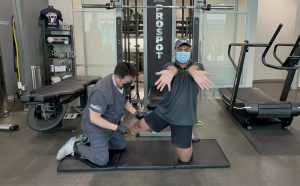Fascia stretching therapy treats plantar fasciitis, neck pain, and other musculoskeletal conditions with therapist assisted stretching and mobility.
What is fascia stretching therapy?
Fascia Stretching Therapy (FST) is centered on the entire connective tissue system as opposed to single muscles. Its practitioners conduct examinations of dynamic, passive, and resisted range-of-motion in functional movements. Treatment begins at the deepest level of fascia and works its way up through all layers until the superficial layer is reached – with a primary intention being that proper neural mechanics will be restored and inhibited muscles reactivated.
What does fascia stretching therapy do?
FST has amazing benefits for those who suffer from chronic pain or stiffness. Not only can it reduce soreness and discomfort, but it also helps to improve circulation, flexibility and mobility; allowing you to recover faster after every workout session. Additionally, FST serves as an ideal supplement to physical therapy by restoring joint range of motion and reducing scar tissue formation.
How is fascia stretching therapy differ from traditional stretching?
Fascia stretching differs from conventional stretching in three primary ways:
- Time element: Myofascial Stretches are held continuously for at least 90-120 seconds. This is how long it takes for the fascia to begin to let go. Shorter stretches do not affect the collagenous aspect of the fascia (connective tissue) and therefore lead to only temporary, partial results.
- Active elongation: This would for example mean actively extending your arm away from the body and telescoping or reaching your arm as if you’re trying to make it longer, feeling how this lengthens the tissue in a three-dimensional way through your arm.
- Stretching and strengthening occur simultaneously during active elongation of the body, muscle groups opposing the tight fascia contract in a sustained manner. This prolonged isometric contraction of muscles against the resistance of the fascial barrier strengthens them, helping to maintain the elongated state of the tissue you’ve just released.

Benefits of fascia stretching therapy
- Pain Reduction
- The restrictions created by fascia can cause physical pain and unnatural postures that up the risk of harm. FST relieves these aches by freeing tightness in this tissue.
- Improve Circulation
- FST improves blood flow by reducing tightness and tension. This further aids recovery after workouts as well as increases energy levels through better oxygen supply to muscles and organs – all while improving your alertness.
- Injury Rehab
- Massage and stretching are widely used to rehabilitate injuries or disassemble scar tissue, especially when a sports injury or surgical procedure has caused harm to the fascia. This damage can be debilitating, as it might restrict motion and mobility while also causing immense pain. Fortunately, one can work through these issues with specialized fascia stretching techniques.
Fascia stretching can be effective in treating the following conditions
- Plantar Fasciitis
- Neck Pain
- Tendonitis
- Muscle Strain
- Fibromyalgia
- Joint Sprains and Strains
The goal of FST is to restore normal range-of-motion and mobility to the affected areas. This not only helps to reduce aches and pains, but it also improves overall performance in the long run.
Whether you’re an athlete or just looking for relief from chronic pain, Fascial Stretch Therapy can help you achieve your goals and get back to feeling better. Talk to a professional to learn more about how FST can improve your quality of life.
- At Koh PT, we use the most effective modalities from all around the globe to ensure optimal healing. Some of these therapies include ShockWave Therapy, Therapeutic Taping, Fascial Manipulation, and Cold Laser Therapy.
